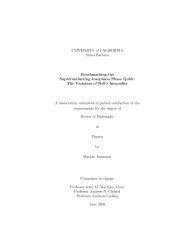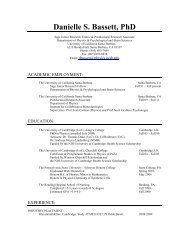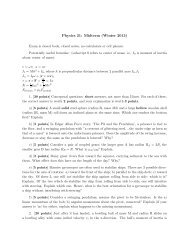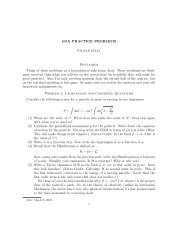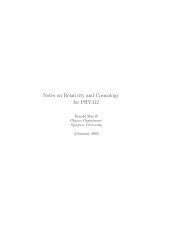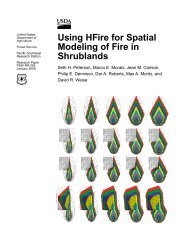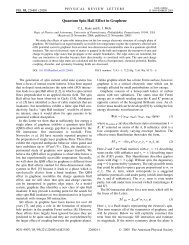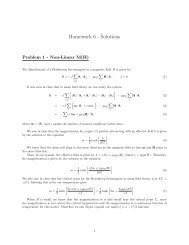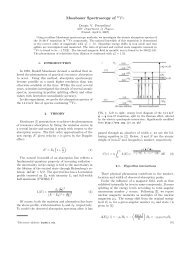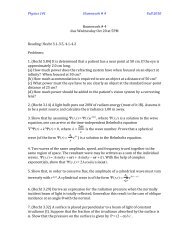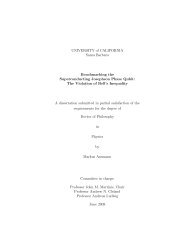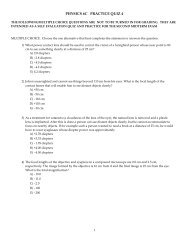Cosmology W13 - Physics Department, UCSB
Cosmology W13 - Physics Department, UCSB
Cosmology W13 - Physics Department, UCSB
Create successful ePaper yourself
Turn your PDF publications into a flip-book with our unique Google optimized e-Paper software.
Lecture 10: February 20 2013 <br />
<strong>Cosmology</strong> <strong>W13</strong>
• Teams and schedule <br />
Presenta:ons
Growth of structure. II <br />
• More on horizons <br />
• Perturba:ons on superhorizon scale <br />
• Adiaba:c fluctua:ons <br />
• Silk damping <br />
• Isothermal perturba:ons <br />
• Baryonic cosmology with isothermal <br />
perturba:ons
Key concepts <br />
• Proper radial distance: <br />
– comoving radial distance projected at :me t <br />
• Par:cle horizon: <br />
– maximum proper distance for causal contact at <br />
:me t <br />
• Event horizon: <br />
– maximum proper distance for an object to ever be <br />
in causal contact
Horizons <br />
r H (t) =3ct matter dominated<br />
r H (t) =2ct radiation dominated<br />
r H (t) = c [e t 1]; = dominated<br />
3
Perturba:ons and horizons <br />
• The analysis described last week holds for small <br />
perturba:ons below horizon scale <br />
• For superhorizon scales one has to a full GR <br />
treatment. In prac:ce (primordial) perturba:ons on <br />
superhorizon scales grow as a 2 (radia:on dominated) <br />
and then as a (maUer dominated) <br />
• Only when they enter the horizon non gravita:onal <br />
physics becomes important, like pressure support <br />
etc
Relevant physical scales <br />
• Par:cle horizon <br />
• Jeans length <br />
j = c s<br />
G<br />
1<br />
2<br />
[non rel]; j = c s<br />
3<br />
8G<br />
1<br />
2<br />
[rel]<br />
• Diffusion lengths, break down of fluid approxima:on <br />
– For Photons (Silk Damping) <br />
– For collisionless par:cles (Free streaming; next :me)
Baryon-‐photon fluid <br />
• Adiaba:c perturba:ons: <br />
– both photons and baryons density – and hence pressure -‐ are <br />
perturbed <br />
– In radia:on dominated phase horizon ~ jeans length so any <br />
perturba:on is stabilized when it enters horizon <br />
– A_er recombina:on jeans length drops <br />
– Photon diffusion damps perturba:on below threshold mass <br />
• Isothermal perturba:ons: <br />
– Only baryons are perturbed against constant T background of <br />
photons <br />
– Similar to above, but no photon diffusion
Speed of sound in baryon-‐photon fluid <br />
• Pre-‐recombina:on they are closely coupled and have <br />
same T <br />
c 2 s =<br />
( p/ T ) S<br />
( r/ T ) S +( m/ T ) S<br />
=<br />
c 2 3<br />
4 r<br />
4 r +3 m<br />
• A_er recombina:on baryons feel only their own <br />
pressure so -‐> thermal sound speed
Evolu:on of Jeans mass <br />
• Radia:on dominated era: <br />
– Photons dominate maUer and pressure, so sound speed is <br />
almost speed of light <br />
– Radia:on pressure suppresses all fluctua:ons below horizon <br />
scale! <br />
r H =2ct = c<br />
3<br />
8G<br />
• MaUer dominated era Jeans mass is constant <br />
• A_er recombina:on sound speed drops, so does Jeans <br />
length and mass! <br />
1<br />
2<br />
j = c<br />
3<br />
24G<br />
1<br />
2
Evolu:on of Jeans mass
Silk Damping <br />
• In adiaba:c fluctua:ons photons are perturbed <br />
• However the fluid approxima:on is only valid for <br />
scales much larger than the diffusion length <br />
• Photons diffuse out of overdensi:es <br />
1<br />
=(N e T ) 1 1<br />
2<br />
; r s<br />
3 ct<br />
• The mas within this length is the “Silk” Mass <br />
M S = 4 3 r3 s<br />
B
Silk Damping. Radia:on era <br />
N e = B c (1 + z) 3<br />
t =<br />
2.4 1019<br />
(1 + z) 2 s<br />
m p<br />
= 11 B h 2 (1 + z) 3 m 3<br />
M S =2.4<br />
10 26 ( B h 2 ) 1/2 (1 + z) 9/2 M
Silk Damping. Up to recombina:on <br />
M S =1.3<br />
10 12 ( 0 h 2 ) 3/2 M<br />
For standard values of Ωb this is 4e14!!!
Evolu:on of instabili:es in adiaba:c <br />
model <br />
Isothermal model is similar but no silk damping, so small scale fluctua:ons are not wiped out
Baryonic-‐Adiaba:c model <br />
• Primordial perturba:on set up early on <br />
• Grow outside horizon as a2 <br />
• At small scales Silk damping wipes them out <br />
• Only large perturba:ons arrive at recombina:on and <br />
start to grow as a (top down approach) <br />
• These structures are large and flaUened and give rise <br />
to topologies similar to those that were known at the <br />
:me (Zeldovich pancakes)
Baryonic-‐Isothermal model <br />
• Primordial perturba:on set up early on <br />
• Grow outside horizon as a2 <br />
• No Silk damping <br />
• All perturba:ons survive to recombina:on and <br />
suddenly they collapse <br />
• Jeans mass is of order ~10 5 -‐10 6 solar masses, smilar to <br />
globular clusters <br />
• Structure grows by merging small things (hierarchical <br />
clustering)
Some Fundamental Problems of <br />
Baryonic <strong>Cosmology</strong> <br />
• Big Bang nucleosynthesis shows that Ω b
The end



